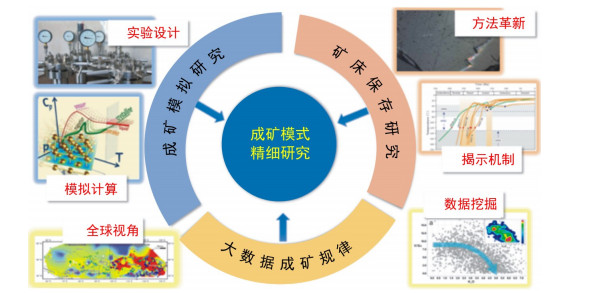Multidimensional study of ore deposits: Current status and future prospects
-
摘要:
21世纪以来,人类正在逐步进入科学技术与社会发展的高速通道,各个科技领域均在发生深刻的变革。现代矿床学经历了百余年的发展和积累,建立了多种不同类型的成矿模式。然而,这些成矿模式的建立主要是通过典型矿床实例研究的“单维度”方法完成的,无论是成矿机制研究本身还是找矿勘查的需求都正在对传统成矿模式研究方式提出挑战。随着以大数据和人工智能为标志的第四次工业革命开始逐步影响基础科学领域,计算模拟和大数据挖掘等技术手段也促使矿床模式的研究进入到一个新的发展阶段。成矿实验和计算模拟、矿床剥蚀保存机制以及成矿规律大数据挖掘等研究方向,与传统矿床实例解剖研究一起,将构成未来我们对成矿模式研究的综合方法。矿床学研究也将由当前的“单维度”走向未来“多维度”的综合研究体系。
Abstract:Since entering the 21st century, human society, including science and technology, has experienced dramatic changes in different fields. The ore deposit study has been continued for over 100 years, and many ore deposit models have been established based on numerous deposit case studies, which can be called the "single-dimension" study method. However, such modeling processes are being challenged by the need for further understanding of ore genesis and implications for mineral exploration. With the involvement of new technology such as big data and AI in geosciences, computing, simulation and big data mining are promoting ore deposit modeling to a new development stage. In the future, the experiments of ore-forming processes facilitated by computing and simulation, the mechanism and evolution of erosion and preservation of ore deposits, the genesis of ore formation using big data analysis and AI technology, together with the traditional ore deposit case studies, will form the new research frame of comprehensive ore deposit modeling, which indicates a transition from the current "single-dimension" study to a more robust "multiple-dimension" study of ore deposits.
-
[1] 陈华勇. 对我国矿床学未来发展方向的思考[J]. 地学前缘, 2020, 27(2): 99-105. https://www.cnki.com.cn/Article/CJFDTOTAL-DXQY202002008.htmChen H Y. Meditations on the future development of ore deposit science in China[J]. Earth Science Frontiers, 2020, 27(2): 99-105(in Chinese with English abstract). https://www.cnki.com.cn/Article/CJFDTOTAL-DXQY202002008.htm [2] 陈华勇, 吴超. 俯冲带斑岩铜矿系统成矿机理与主要挑战[J]. 中国科学: 地球科学, 2020, 50(7): 865-886.Chen H Y, Wu C. Metallogenesis and major challenges of porphyry copper systems above subduction zones[J]. Science China Earth Sciences, 2020, 63(7): 899-918(in Chinese with English abstract). [3] Sillitoe R H. Porphyry copper systems[J]. Economic Geology, 2010, 105: 3-41. doi: 10.2113/gsecongeo.105.1.3 [4] Wilkinson J J, Chang Z S, Cooke D R, et al. The chlorite proximitor: A new tool for detecting porphyry ore deposits[J]. Journal of Geochemical Exploration, 2015, 152: 10-26. doi: 10.1016/j.gexplo.2015.01.005 [5] Skirrow R. Ironoxide copper-gold (IOCG) deposits: A review (part 1): Settings, mineralogy, ore geochemistry and classification[J]. Ore Geology Reviews, 2022, 140: 1-36. [6] Li J P, Chen H Y, Liu W H, et al. Copper mobilization via seawater-volcanic rock interactions: New experimental constraints for the formation of the ironoxide Cu-Au (IOCG) mineralization[J]. Geochimica et Cosmochimica Acta, 2022, 330: 209-229. doi: 10.1016/j.gca.2022.06.004 [7] 翟裕生. 论成矿系统[J]. 地学前缘, 1999, 6(1): 13-27. https://www.cnki.com.cn/Article/CJFDTOTAL-DXQY901.002.htmZhai Y S. On the metallogenic system[J]. Earth Science Frontiers, 1999, 6(1): 13-27(in Chinese with English abstract). https://www.cnki.com.cn/Article/CJFDTOTAL-DXQY901.002.htm [8] Gong L, Kohn B P, Zhang Z Y, et al. Exhumation and preservation of paleozoic porphyry Cu deposits: Insights from the Yandong Deposit, southern Central Asian Orogenic Belt[J]. Economic Geology, 2021, 116(3): 607-628. doi: 10.5382/econgeo.4812 [9] Wu C, Chen H Y, Lu Y J. Magmatic water content and crustal evolution control on porphyry systems: Insights from the central Asian Orogenic Belt[J]. Journal of Petrology, 2021, 62(2): 1-15. [10] Wu C, Chen H Y, Lu Y J. Crustal structure control on porphyry copper systems in accretion aryorogens: Insights from Nd isotopic mapping in the Central Asian Orogenic Belt[J]. Mineralium Deposita, 2022, 57(4): 631-641. -





 下载:
下载:




